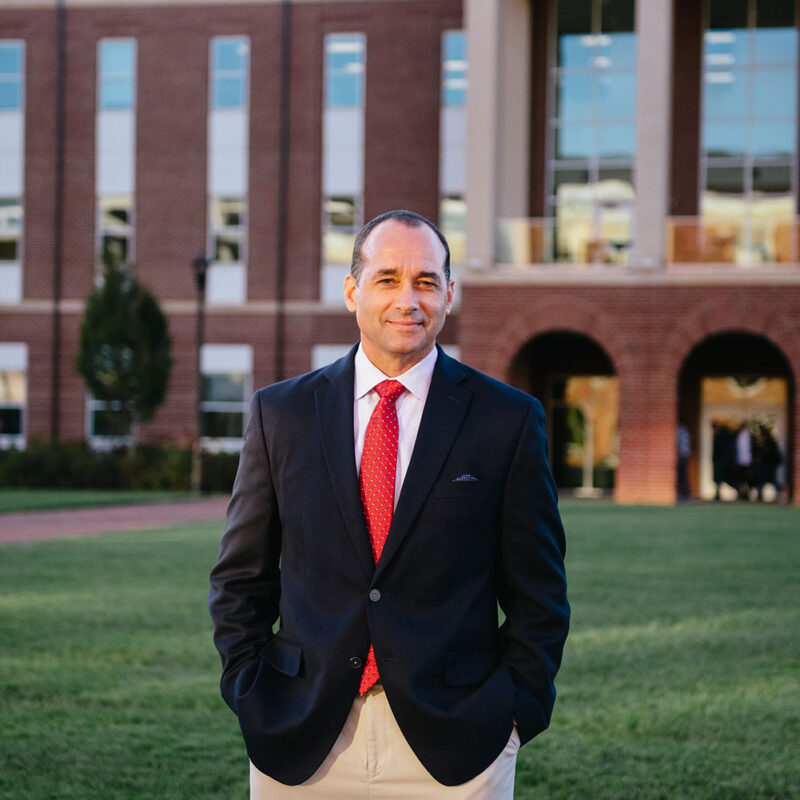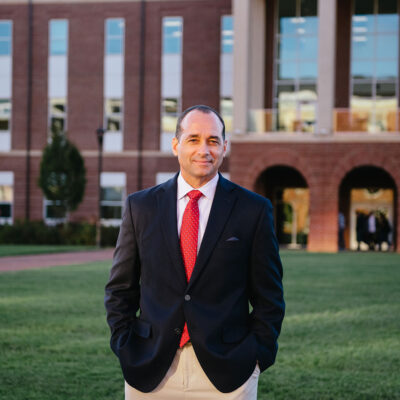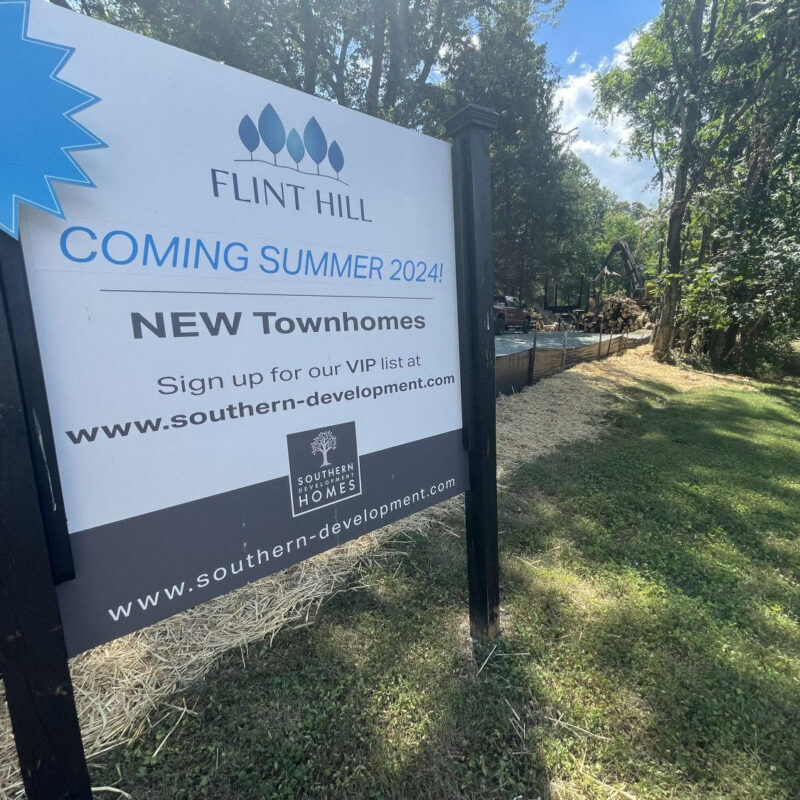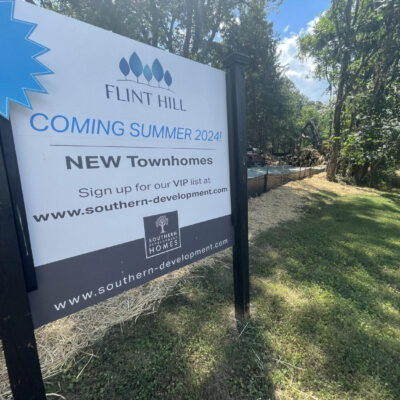It’s hard to believe, but Peter Hatch didn’t have gardening in his blood. Now 32 years into his work restoring the gardens at Monticello, a task that his former boss says makes him “known to every historical gardener in America,” Hatch’s early aspiration was to be a poet. And in a sense—a living, dirt-under-your-nails, sticky-stuff-on-your-forearms kind of way—he is. Surely there’s poetry in the way the luminous tropical leaves of the Okra plants present themselves in the morning light, in the transcendent view towards the hills of Albemarle County, in the prehistoric and strangely reptilian Brussels sprouts. It might be more labor than lyric to spend hours on all fours, pushing tiny dried Crowder Peas about an inch down into the soil, with the ball of your thumb, each seed spaced about an inch apart—replacing the slave crop, because the deer had eaten them the night before—but that too has its beauty.
|
Even a single Nasturtium shall meet standards of historical authenticity—to say nothing of beauty. |
Still, given the meticulous and delicate attention paid to horticultural tasks on the 2,400-acre mountaintop estate, such as gathering heirloom seeds from the desiccated bushes of the Brown Dutch Lettuce before they’re uprooted for the season, it’s somewhat incongruous to imagine that Hatch—a muscular man who, with his infectious laugh and wild hair, looks like a cross between Beethoven and a wood spirit—spent his youth in the Midwest, pounding hockey pucks into a net. But Monticello is, above all else, Jefferson Country, an estate that’s as beautiful as it is historically accurate, right down to the smallest detail. The seedline, for example, along which we planted that straight row of Crowder Peas one morning, was handmade from the Yucca plants grown here, just as it was done in Jefferson’s day. Or the natural defenses against deer, such as ash scattered at the base of the Lavender plants—these are almost obsessively vetted for historical accuracy.
It wasn’t always that way at Monticello, though. When Hatch was hired in 1977 to restore the gardens, Thomas Jefferson’s Revolutionary Vegetable Garden instead sprouted flowers for arrangements in the house. Mulberry Row, that famous alley of light industry for the plantation, including the joinery and blacksmith shop, was paved, which is hard to believe now, when historical authenticity is the norm, especially given the importance of Building O, one of the first slave cabins built at Monticello.
Back then tour buses idled in a parking lot not 100 yards from the East Portico. Back then there was even some resistance to the restoration, as some employees resented the shift in emphasis from pure aesthetics to historical accuracy. “I tried to emphasize that this was a sacred place, and that we had this singular documentary record and we needed to be faithful to it,” Hatch explains one afternoon as he walks me through the stages of the restoration, from Upper and Lower Grove, to the Flowerbeds on the West Lawn, to the Vegetable Garden. “It was convincing to some people, but probably not to others, but there was no question that that’s what we were going to do at Monticello.”
|
|
Tellingly, for Hatch, officially known as the Director of Gardens and Grounds at Monticello, and author of such classic books on horticulture and historical restoration as The Gardens of Monticello and The Fruit Trees of Monticello, one of the most important things about this massive restoration project is not how much it cost, nor that Monticello became the only house in America that’s a World Heritage site in 1988, but that the third president often worked here in the garden, alongside slaves like Wormley Hughes, the man who dug Jefferson’s grave and has been described as Monticello’s head gardener.
“Four or five times he came out here to lay out these garden squares. He had his transit, called a theodolite, and a chain to measure distances—the theodolite measured right angles. He did this as late as 1815, when he was 72 years old. You can imagine Jefferson himself, out here with the chain and the theodolite measuring the particular squares, Wormley maybe helping him with the chain, Jefferson bent over, arthritic.”
And this in itself is the key to Hatch’s work. Much more than a man who believes that “gardening breeds happiness,” much more than a horticulturist and manager charged with the upkeep and maintenance of an historical estate and major tourist site, Hatch is both “lyrical scholar,” as one Washington Post reporter called him, and garden master. He is the man who, along with a team of architects, historians, archeologists and fundraisers, was tasked with bringing this historical and horticultural wonder back to life from Jefferson’s writings and sketches. Therefore Hatch must keep his mind in two places at once: the world of Thomas Jefferson’s Garden Book, and the world of the compost pile that steams by the spadeful near his office.
Like Jefferson, Peter Hatch is largely self-taught. His father was a Madison Avenue ad executive whom Hatch describes as “just the least physical man.” A child of the ’60s, Hatch, now 60 years old, rebelled against the world of his parents and turned to poetry. He calls his a downwardly mobile education: fancy boys’ school in Michigan, where he played ice hockey; good state university in Chapel Hill, where he studied English and developed a taste for poetry; and then, after a stint on the West Coast, community college, also in North Carolina. Hatch was living in Southern California when his college girlfriend dumped him for the fourth time, so he drove back across the country to interview for a job teaching English at a boarding school in Boston, only to be rejected there, too. But as Jefferson once wrote, and Hatch likes to say, the failure of one thing is repaired by the success of another: in this case, manure.
|
Peter Hatch, whose books The Gardens of Monticello and The Fruit Trees of Monticello are standard-bearers in historic gardening, spreads the word to gardeners, educators and professionals who were on a tour last month of Monticello’s grounds. |
Fate, or a want of it, lead him back to Chapel Hill, where he started an organic garden in 1972 because a friend “wouldn’t stop talking about the joys of shoveling manure. It just struck me as this gentle occupation that was well-worthy of a young poet, that I could garden in the daytime and write poetry in the evening.”
He enrolled in the landscape gardening program at Sandhills Community College. His first big break as a gardener came shortly thereafter in 1974, when he was hired as a horticulturist at Old Salem, in Winston-Salem, North Carolina, at the landscape restoration program started by Flora Anne Bynum, “a superb restoration that also happens to be lived in,” Hatch says. (It also happens to be where I grew up, and according to my mother, followed Hatch around the gardens as a small child whenever we visited Old Salem. “Boy, I remember, $5 an hour was a big deal back then,” Hatch says. But he doesn’t remember me.)
The Monticello restoration project is and continues to be an enormous accomplishment. You can see it by just looking at photos that contrast the Monticello of today to the Monticello of 1977, when Peter Hatch was hired as the Superintendent of Grounds. He initially turned down the job, because he played right wing on the Winston-Salem All Star soccer team. But he soon came to his senses and warmed to the challenge. Back then, there was no South Orchard, with its hundreds of fruit trees and its berry squares of currants, gooseberries, raspberries and figs. Nor was there a nursery, which was Jefferson’s horticultural laboratory, where he cultivated and grafted plants from the Lewis and Clark expedition. There were no vineyards of Sangiovese, no meticulously recreated roundabouts of Wild Crabapple and Chinaberry trees. The restoration of the Upper and Lower Grove was still in the planning stages. All of that had yet to be remade, at a cost that would be impossible to tally, according to Director of Restoration William Beiswanger. Not a single stone of the garden retaining wall from Jefferson’s day remained, not even in a scattered aspect, as the Civilian Conservation Corps had carted them away in the 1930s to build a modern-day highway exit wall.
|
Sesame seed pods in Hatch’s hands. |
The secrets of Jefferson’s horticultural vision lay buried in two places: in the ground, sometimes under pavement, and in the historical documentation that Jefferson left behind—sketches and plans both hurried and carefully made, the exhaustive garden journal that was edited by Edmund Butts and published in 1948, entitled Thomas Jefferson’s Garden Book, and over 17,000 letters that Jefferson wrote. Along with Beiswanger and archeologist William Kelso, also known for his work at Jamestown, and a small team of landscape architects, surveyors, geologists, masons and horticulturists, Hatch built and planted it anew—tree by tree, shrub after shrub, stone by stone, plant after plant, sometimes grafting trees, sometimes growing plants from seed, but never using hybrids. Gabriele Rausse, who as Hatch’s deputy is in charge of the actual propagation of plants, calls this a guarantee of uniformity. “Plants are like people; one comes out well, some not so well. So you have a chance to propagate the best.”
The year Hatch was hired was also the year after the Bicentennial, during which Monticello had 650,000 visitors. In those days there was a ban on fundraising and a focus on what Hatch calls “patriotic tourism.” Nonetheless, the beginnings of the restoration project were financed entirely by ticket and merchandise sales. Under Dan Jordan, who was President of the Thomas Jefferson Foundation from 1985 until 2008, the rather naive ban on fundraising was reversed. Since that time, a capital campaign led by philanthropist Thomas A. Saunders III has raised as much as $100 million. Though Hatch didn’t do actual fundraising at the time, according to Jordan he leant credibility to the fundraising process, as in, This is what your dollars could do.
The irony is that since things have gotten more accurate at Monticello, ticket sales have declined, which Hatch attributes to things like theme parks, Disney history, and the Internet. Perhaps in response, current President Leslie Greene Bowman is widely expected to lead Monticello even further in the direction of educational programs, along the lines of the Saturdays in the Garden Series, with its workshops on making rain barrels and fruit tastings, and the Historic Landscape Institute, a summer school in conjunction with UVA.
|
Gabriele Rausse, near Monticello’s greenhouses, where he is in charge of the actual propagation of plants. Hybrids are never used. |
The restorations and Hatch’s career grew commensurate with one another. Promising in the early days, he is now a known leader in historical garden restoration. In addition, his work makes its way into the mainstream through events like this weekend’s Heritage Harvest Festival at Tufton Farm, which features traditional agriculture, sustainable gardening and the local food movement.
The historic gardening community “knows him through his writing, through his lectures, through his leadership in professional organizations. They know him through the work he’s done at Monticello,” Jordan says. He, like Hatch himself, stresses that the project was very much the work of a team, principally consisting of Beiswanger, Kelso, and of course Hatch.
“That particular trio stood for the highest standards of historical restoration,” Jordan says. “Unless they could find physical evidence to go along with documentary evidence, they didn’t pursue a project. But if they found a match, then they would move forward.”
Take the first full project to be started and completed during Hatch’s tenure, which began with a plan designed by Beiswanger. It was called, simply, “Conceptual Plan of the Monticello Vegetable Garden Terrace Orchard, Vineyards, 1809-1826.” As the dates suggest, Beiswanger painstakingly recreated it from Jefferson’s drafts and writings of that period. Ultimately, there were three versions that reflected that “physical evidence” Jordan referred to, that is, the archeology conducted by Kelso.
The actual physical work, from the archeology, to the rebuilding of structures, to the location and planting of sometimes incredibly rare plant species, was even more intricate and painstaking than the research. “Every time you disturb our red clay soil,” Hatch says, “you leave some sort of lasting imprint in terms of texture and the color of the soil itself. The archeologists begin opening up 3’x3’ squares, pits, and they try to find staining in the ground, and in some cases the stains in the ground can illuminate where fence posts were, or where trees were growing hundreds of years ago.”
With the archeological results, along with results from a floristic study, or botanical survey of everything that grows on Monticello Mountain, Beiswanger was able to create a plan of the entire South Orchard. Hatch has been nonchalant as we walk from stage to stage, almost dismissing decades of work with a wave of the hand and a laugh, but when we come to the orchard, for the first time I can see the enormity of the project in his eyes, in the way he identifies each tree.
|
Historic seeds are now packaged and sold through Monticello, which has become a locus for traditional agriculture and sustainable gardening, as this weekend’s upcming Heritage Harvest Festival attests. |
“Large sections of the orchard site were stripped clean and carefully excavated. And the archeologist after stripping the land and doing excavations in various places found 59 stains where the original trees were growing. They put newspaper over all of these stains and it formed a pattern, just identical to a grid map Jefferson had drawn in 1778.”
Hatch’s job was to take the conceptual plans and bring them to life. “Then it becomes more my process of restoring and finding the actual varieties of tree,” or plant, in the case of the garden, from private individuals who make it their business to collect historical varieties, or commercial nurseries, or in some cases, by hiring specialists to propagate the tree or plant at Monticello.
As Saunders says, Hatch is “the person who could bring real practical sense to this vision and translate it into reality.”
“The plant search is really a detective search,” Hatch says. Take one of the stories from the planting of the Upper Grove in the late 1970s, this “museum for trees” that took at least two years to plant and involved “hundreds of trees and probably over a thousand shrubs.” One of Jefferson’s favorite trees was the Chinaberry, an Asian tree that grows in the South and, according to Hatch, is a bit of a weed. For that reason, no commercial nurseries sold it. But Jefferson’s letters and plans specify they were planted in the grove on the northwest side of the mountain. “It’s a tree intimately associated with lowlife Southern culture, with country boys and moonpies,” he says. An extensive hunt turned up only two rather miserable specimens that quickly died.
As it turned out, two of Hatch’s friends were lawyers in a small town in North Carolina, and they offered to spring a man from jail if he agreed to deliver some “Chainyball” trees to Monticello. “Lo and behold, the very next day these beautiful trees arrive all bundled up, and they provided the next generation of Chinaberry trees at Monticello.” Before I can question this tale Hatch erupts into laughter.
This story illustrates what Hatch calls “the uneasy relationship between history and horticulture,” because the trees are an exotic invasive, and no horticulturist in his right mind would have planted them had Jefferson not mentioned them in his papers. The value of repeating one of Jefferson’s failed experiments is that “it’s living history.” And here Hatch drops in that Jefferson quotation for the third time in a day: “The failure of one thing is repaired by the success of another.”
Two such successes clearly illustrate what has to be a big part of Hatch’s job, “to protect Monticello,” as Senior Groundskeeper Robert Johnson bluntly put it. The first is the Parkway Project, the most recent phase of the restoration to be completed—what Jordan has described as “a 179-acre linear park that is designed to protect the entrance corridor to Monticello from commercial development,” including Saunders Bridge, Saunders-Monticello Trail, and Kemper Park. The second success was the 2004 purchase of Montalto, or Brown’s Mountain, to prevent condos from being built there, something that Hatch calls “a victory for historic preservation.” The irony of this purchase isn’t that it cost the exact same as the Louisiana Purchase, $15 million, a fact that both the Monticello website and Jordan touts, but that Monticello has to be protected from a world Jefferson helped to create.
Hatch thinks an even better way to do this is through education. After all, gardening was for Jefferson “a vehicle for social change,” and it’s important that people know this dimension of Jefferson’s life. When I ask Hatch about his legacy, for the first time in our interview, his voice cracks, not with laughter but with pride, and he smiles. “The educational programs are probably my greatest accomplishment.”
|
In the early 1970s, before Hatch joined Monticello and the massive horticultural restoration project began, the property included a parking lot not 100 yards from the house itself, and plantings that were more aesthetic than historic. |
You can see that pride in the way he’s constantly doing stuff as we walk, picking up a ticket stub, or snapping a tentworm nest from a Magnolia tree. You can see it in the way he talks about the compost, as he turns it in the back of one of the golf carts. “That’s the magic elixir of gardening right here, homemade compost. This is power right here, this compost, and we love to put this in the soil and make Thomas Jefferson’s land richer. That’s really a great feeling.”
Peter Hatch has been called a lyrical scholar, an expert, and the Overseer of Monticello. He certainly evinces the mind of a good scholar and the toughness of a man who signs 45 timesheets every fortnight. He’s also a great gardener. One glimpse at Monticello reveals that. But in order to see that he has the heart of a poet, you have to let Hatch name himself:
“I’m a big tree guy. I love native trees,” like the White Oak, or the Franklinia, which he tells me was named for Benjamin Franklin, and, (strangely enough) has trouble propagating itself. “I love caring for trees, though it’s not that simple, it’s another complex role that I perform. Trees live and die. We lost a huge tree a year ago. That was just the most painful thing I’ve ever been through. The trunk’s right up there now,” he says, gesturing to the massive stump of a Tulip Poplar that once loomed over the south side of the house, and that might even date to before Jefferson’s time.
“That was pretty traumatic. That kept me awake. This was like one of my children, this was an integral part of my identity, and it was suffering on its way out. There were times when I did cry. I had a couple of crying tantrums with other people and a couple times by myself.” And for a moment, I’m afraid there might be another one as we stand there in silence at the grave of the great, “original” tree.
Not to worry though. This is Monticello, and Jefferson Country springs from “the powers of the earth.” Before Hatch gets too sad, he’s already off in a different direction and laughing again, telling me how a new generation of Tulip Poplars has already been grafted from the germ plasm of this tree—a tangible link to Jefferson’s time.

 An aerial view of the grounds at Monticello, which Peter Hatch has spent 32 years restoring.
An aerial view of the grounds at Monticello, which Peter Hatch has spent 32 years restoring.









